
Isoroku Yamamoto was a Marshal Admiral of the Imperial Japanese Navy (IJN) and the commander-in-chief of the Combined Fleet during World War II. Yamamoto held several important posts in the Imperial Navy, and undertook many of its changes and reorganizations, especially its development of naval aviation. He was the commander-in-chief during the early years of the Pacific War and oversaw major engagements including the attack on Pearl Harbor and the Battle of Midway. Yamamoto was killed in April 1943 after American code breakers identified his flight plans, enabling the United States Army Air Forces to shoot down his aircraft.

Oahu is the most populated and third-largest of the Hawaiian Islands. The island of Oahu and the Northwestern Hawaiian Islands constitute the City and County of Honolulu. The state capital, Honolulu, is on Oahu's southeast coast. In 2021, Oahu had a population of 995,638, up from 953,207 in 2010.

Tora! Tora! Tora! is a 1970 epic war film that dramatizes the events leading up to the Japanese attack on Pearl Harbor in 1941, from the American and Japanese positions. The film was produced by Elmo Williams and directed by Richard Fleischer, Toshio Masuda and Kinji Fukasaku, and stars an ensemble cast including Martin Balsam, Joseph Cotten, So Yamamura, E.G. Marshall, James Whitmore, Tatsuya Mihashi, Takahiro Tamura, Wesley Addy, and Jason Robards. It was Masuda and Fukasaku's first English-language film, and first international co-production. The tora of the title, although literally meaning "tiger", is actually an abbreviation of a two-syllable codeword, used to indicate that complete surprise had been achieved.
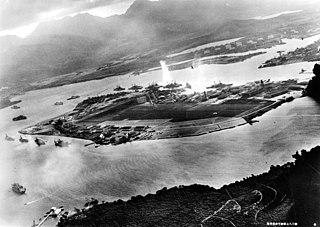
The attack on Pearl Harbor was a surprise military strike by the Imperial Japanese Navy Air Service on the American naval base at Pearl Harbor in Honolulu, Hawaii, in the United States, just before 8:00 a.m. on Sunday, December 7, 1941. At the time, the United States was a neutral country in World War II. The attack on Hawaii and other U.S. territories led the United States to formally enter World War II on the side of the Allies the day following the attack, on December 8, 1941. The Japanese military leadership referred to the attack as the Hawaii Operation and Operation AI, and as Operation Z during its planning.

The United States Pacific Fleet (USPACFLT) is a theater-level component command of the United States Navy, located in the Pacific Ocean. It provides naval forces to the Indo-Pacific Command. Fleet headquarters is at Joint Base Pearl Harbor–Hickam, Hawaii, with large secondary facilities at Naval Air Station North Island, California.

USS Nashville (CL-43) was a Brooklyn-class cruiser. She was laid down on 24 January 1935 by New York Shipbuilding Corporation, Camden, New Jersey. She was launched on 2 October 1937, sponsored by Misses Ann and Mildred Stahlman and commissioned on 6 June 1938.

Admiral Harry Ervin Yarnell was an American naval officer whose career spanned over 51 years and three wars, from the Spanish–American War through World War II.
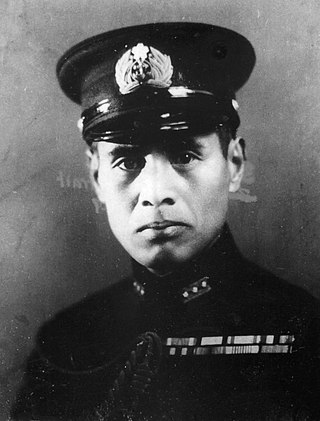
General Minoru Genda was a Imperial Japanese Navy flight officer, JASDF general and politician. He is best known for helping to plan the attack on Pearl Harbor. After the war he became the third Chief of Staff of the Japan Air Self-Defense Force.
The Pacific War is a series of alternate history novels written by Newt Gingrich and William R. Forstchen with Albert S. Hanser. The series deals with the Pacific War between the United States of America and the Empire of Japan. The point of divergence is the decision of Admiral Isoroku Yamamoto, commander-in-chief of the Japanese Combined Fleet, to take personal command of the 1st Air Fleet for the attack on Pearl Harbor, rather than delegate it to Adm. Chūichi Nagumo.
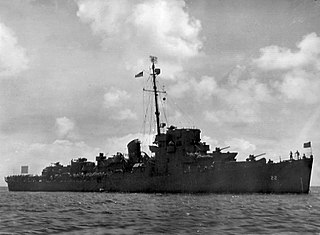
USS Wileman (DE-22) was an Evarts-class destroyer escort constructed for the United States Navy during World War II. It was promptly sent off into the Pacific Ocean to protect convoys and other ships from Japanese submarines and fighter aircraft. At the end of the war, she returned to the United States proudly displaying four battle stars.

USS Vireo (AM-52) was a U.S. Navy Lapwing-class minesweeper, No. 52, reclassified on 1 June 1942 as a fleet tug. The bulk of her combat career was served in this capacity.

A series of events led to the attack on Pearl Harbor. War between the Empire of Japan and the United States was a possibility each nation's military forces had planned for after World War I. The expansion of American territories in the Pacific had been a threat to Japan since the 1890s, but real tensions did not begin until the Japanese invasion of Manchuria in 1931.

Pearl Harbor is an American lagoon harbor on the island of Oahu, Hawaii, west of Honolulu. It was often visited by the naval fleet of the United States, before it was acquired from the Hawaiian Kingdom by the U.S. with the signing of the Reciprocity Treaty of 1875. Much of the harbor and surrounding lands are now a United States Navy deep-water naval base. It is also the headquarters of the United States Pacific Fleet. The U.S. government first obtained exclusive use of the inlet and the right to maintain a repair and coaling station for ships here in 1887. The surprise attack on the harbor by the Imperial Japanese Navy on December 7, 1941, led the United States to declare war on the Empire of Japan, marking the United States' entry into World War II.
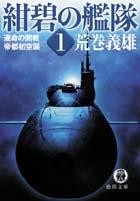
Konpeki no Kantai is a Japanese alternate history series produced by J.C.Staff. The series focuses on both a technologically-advanced Imperial Japanese Navy and a radically-different World War II that were brought about by Admiral Isoroku Yamamoto's revival by unexplained circumstances. Both the published books and the original video animation (OVA) series are also notable for using the Imperial Japanese calendar, instead of the Western calendar, in denoting the years in which the events of the series take place. It also spawned a 1997 OVA side story, Kyokujitsu no Kantai, one manga sequel, and two turn-based strategy games for the PC-FX and the Super Famicom.
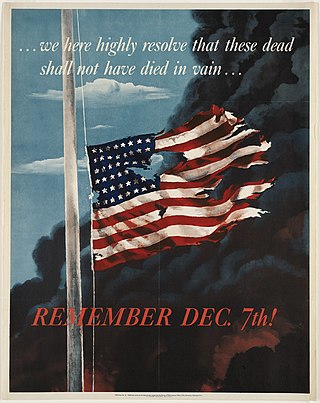
National Pearl Harbor Remembrance Day, also referred to as Pearl Harbor Remembrance Day or Pearl Harbor Day, is observed annually in the United States on December 7, to remember and honor the 2,403 Americans who were killed in the Japanese surprise attack on Pearl Harbor in Hawaii on December 7, 1941, which led to the United States declaring war on Japan the next day and thus entering World War II.

Naval Station Pearl Harbor is a United States naval base on the island of Oahu, Hawaii. In 2010, as part of the recommendations of the Base Realignment and Closure (BRAC) commission, the naval station was consolidated with the United States Air Force's Hickam Air Force Base to form Joint Base Pearl Harbor–Hickam. Since 1940, Pearl Harbor has been the headquarters of the United States Pacific Fleet.
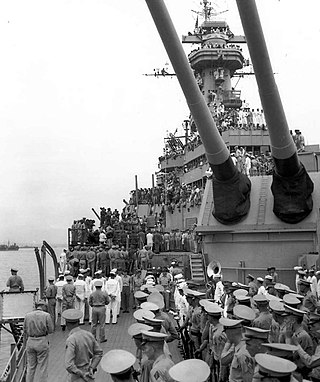
The United States Navy grew rapidly during its involvement in World War II from 1941–45, and played a central role in the Pacific War against Imperial Japan. It also assisted the British Royal Navy in the naval war against Nazi Germany and Fascist Italy. The U.S. Navy grew slowly in the years prior to World War II, due in part to international limitations on naval construction in the 1920s. Battleship production restarted in 1937, commencing with the USS North Carolina. The US Navy was able to add to its fleets during the early years of the war while the US was still neutral, increasing production of vessels both large and small, deploying a navy of nearly 350 major combatant ships by December 1941 and having an equal number under construction.

The attack on Pearl Harbor has received substantial attention in popular culture in multiple media and cultural formats including film, architecture, memorial statues, non-fiction writing, historical writing, and historical fiction. Today, the USS Arizona Memorial on the island of Oahu honors the dead. Visitors to the memorial reach it via boats from the naval base at Pearl Harbor. The memorial was designed by Alfred Preis, and has a sagging center but strong and vigorous ends, expressing "initial defeat and ultimate victory". It commemorates all lives lost on December 7, 1941.

Naval Base Hawaii was a number of United States Navy bases in the Territory of Hawaii during World War II. At the start of the war, much of the Hawaiian Islands was converted from tourism to a United States Armed Forces base. With the loss of US Naval Base Philippines in Philippines campaign of 1941 and 1942, Hawaii became the US Navy's main base for the early part of the island-hopping Pacific War against Empire of Japan. Naval Station Pearl Harbor was founded in 1899 with the annexation of Hawaii.

A series of operations by American aircraft carriers was undertaken in the first half of 1942 in response to the Japanese attack on Pearl Harbor. Six American air-naval operations conducted from January to the end of April 1942 were aimed at harassing Japan during the height of the Japanese offensive in Southeast Asia, improving the morale of the American forces, which had deteriorated after the attack on Pearl Harbor, and also showing Japan that despite all the defeats of the Allies during this time, United States Navy can carry out effective strikes. The last of these raids directly accelerated the Japanese attack on Midway, which had strategic consequences for the Pacific War.



















